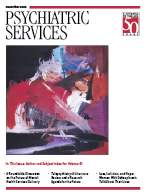Service Use Over Time and Achievement of Stable Housing in a Mentally Ill Homeless Population
Abstract
OBJECTIVE: Service use among clients of a multiservice agency serving homeless persons with severe mental illness was examined to determine whether patterns of service use reflected two stages in an adaptation of the transtheoretical model of change. In the adapted model, change occurs in five stages—pre-engagement, contemplation, engagement, the strategic moment, and consolidation. It was hypothesized that rates of service use would be highest immediately after clients obtained housing (the strategic moment) and would decrease in the months afterward (consolidation stage), with the greatest decreases occurring immediately after housing was obtained. METHODS: Service use data were collected for two groups: a housed group of 58 clients who had obtained and sustained stable housing for at least 24 consecutive months at the time of sampling and an unhoused group of 55 clients who were matched with the housed clients on month of service entry. Total service use and use of three service types—a drop-in center, counseling, and health services—were examined to test the hypotheses. It was hypothesized that use of services by the unhoused group would show a consistent linear decline rather than a two-stage decline. Linear spline regression using bootstrap sampling methods was used to fit service use data for both groups. RESULTS: The two-stage solution significantly modeled the patterns of service use by the housed but not the unhoused clients, supporting the hypotheses. For the housed group, use of the drop-in center and counseling fit the model, and use of health services did not. CONCLUSIONS: The results provide limited support for the hypothesized five-stage model for achieving change.



